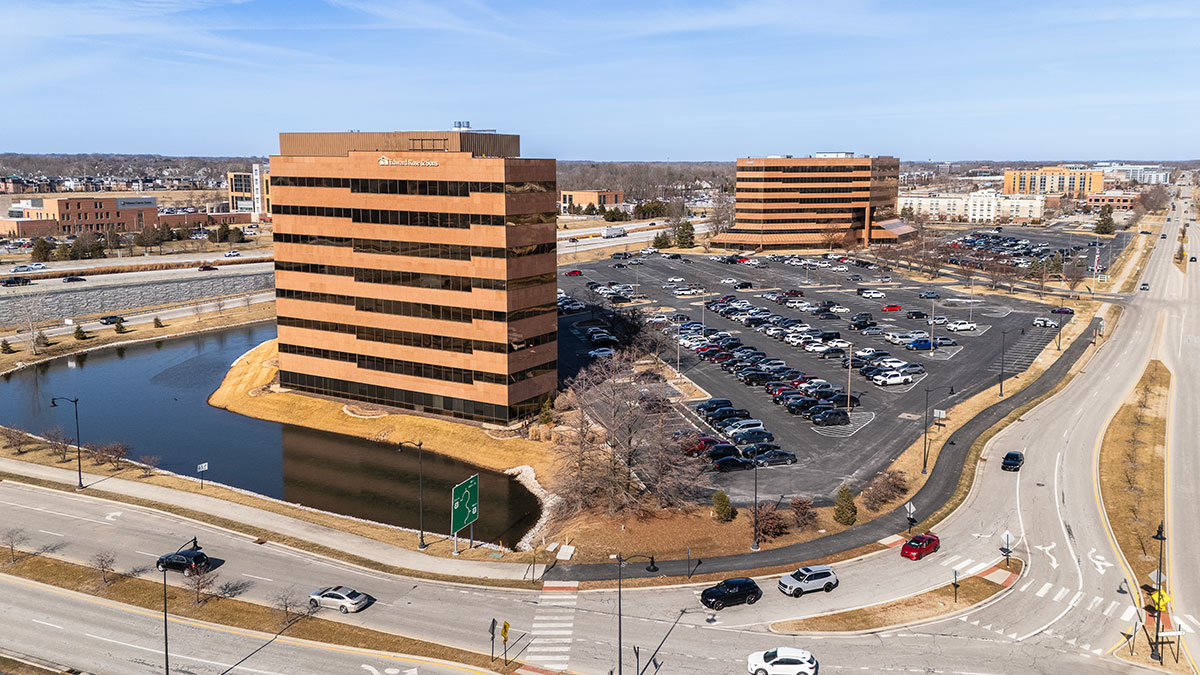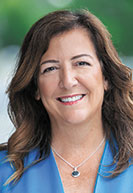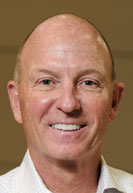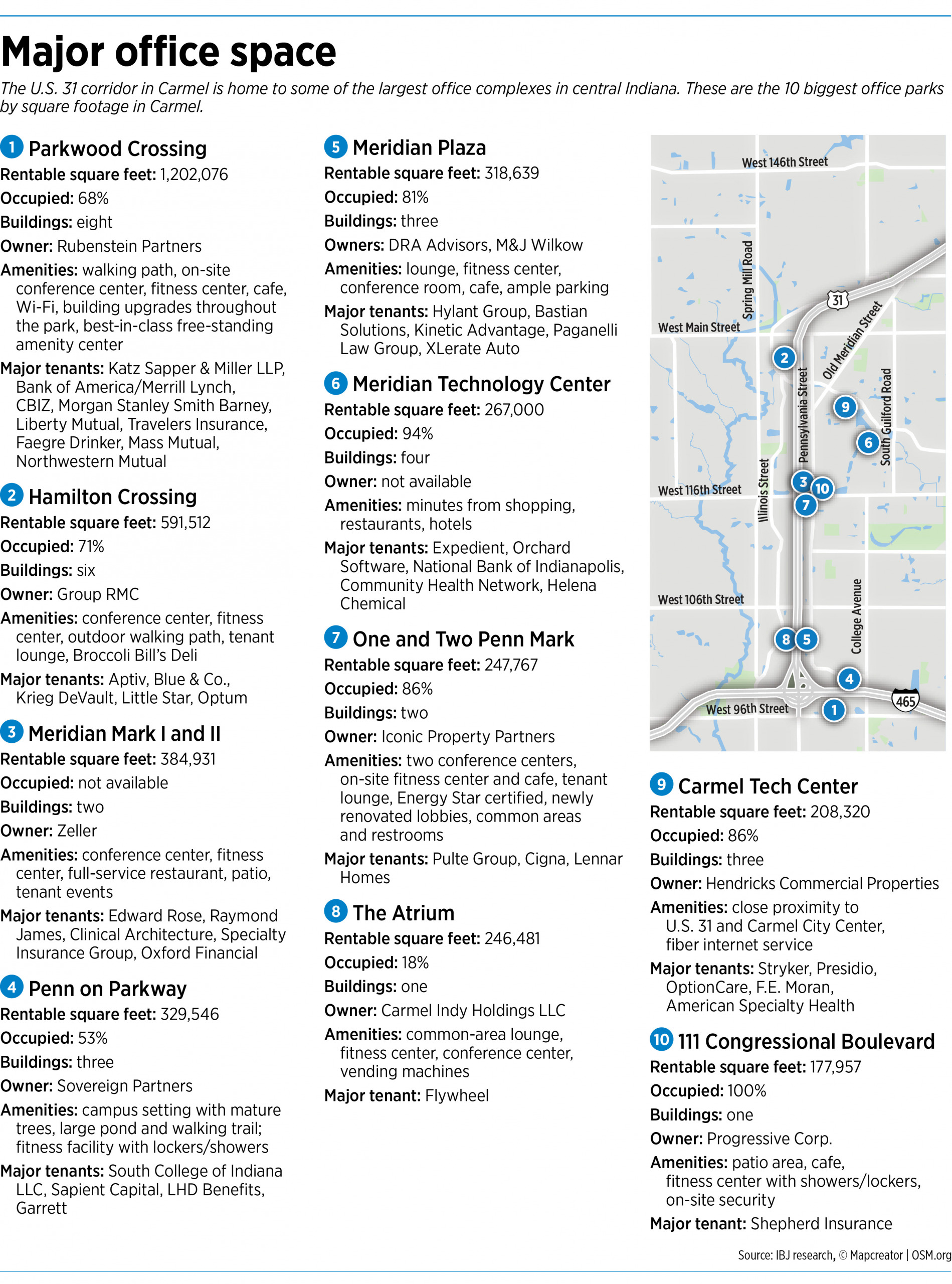Subscriber Benefit
As a subscriber you can listen to articles at work, in the car, or while you work out. Subscribe NowThe high-rise office buildings that line U.S. 31 in Carmel have provided an economic engine that the city has used to become a suburban powerhouse.
For the past 35 years, the North Meridian Street business corridor has been a natural place to call home for many of the 125 companies that chose Carmel for their corporate headquarters.
And the corridor created a commercial tax base that helped the city keep its tax rate among the lowest in the state, while it built a nationally renowned urban core that has become a magnet for residents, tourists, businesses and developers.
But increasing vacancy rates fueled by both the pandemic and changing attitudes about what company executives and workers want in their office space have led Carmel leaders to take a fresh look at the corridor and determine how to give it a second act.
Think more dense, mixed-use development of the type that has been successful in Carmel’s Midtown, Arts & Design District and City Center instead of office buildings surrounded by acres of asphalt parking lots.
“It’s been a great corridor for us from an economic development standpoint,” Mayor Sue Finkam said. “But times change, and COVID really changed the way people interact with office space.”
The U.S. 31 corridor runs the length of Carmel, 6 miles, from 96th Street to 146th Street south to north, and from Spring Mill Road to College Avenue west to east. It includes the largest office complex in central Indiana—the 1.2-million-square-foot Parkwood Crossing at Interstate 465 and North Meridian Street, which is owned by Philadelphia-based Rubenstein Partners and has undergone $36.4 million in reinvestment in recent years to update building systems, indoor and outdoor amenities, lobby spaces, restrooms, and facades.
While the buildings along U.S. 31 are privately owned, Carmel leaders are beginning to look at ways to work with owners to renovate or redevelop properties.
Carmel Executive Director of Economic Development Nick Weber said it is likely that buildings will either remain in place with infill construction and a new road system around them, or they will be demolished to create a blank slate. The short ceilings, large floor sizes, old wiring and outdated HVAC systems might make renovating some buildings difficult.
“These buildings are not new and would need work in the foreseeable future,” Weber said. “It’s a 6-mile corridor, so there’s lots of opportunities. I think the nice thing is, it doesn’t have to be one thing.”
Likewise, Finkam said some buildings are not conducive to being refabricated into new office space and would not easily be remade into residential buildings.
“So, the likelihood that many of these buildings would be scrapped is pretty high, eventually,” she said. “We’re looking for investment opportunities that will bring new, better-built, more desirable, multi-use areas to that corridor.”

Change in taste
The corridor’s story began in the 1970s when Carmel chose to zone for high-rise office development there instead of for the strip malls, gas stations and fast-food restaurants that line major roadways in Indianapolis and other central Indiana suburban cities. By the 1980s and 1990s, a building boom along U.S. 31 was underway that turned the corridor into Indiana’s second-largest commercial hub behind downtown Indianapolis.
Traci Kapsalis, executive vice president of leasing and office sales at the Indianapolis office of Chicago-based JLL, said the U.S. 31 corridor is a “very well-known, prominent corporate address” that “carries a lot of weight from a prestige standpoint.”
“A lot of decision-makers lived up that way and wanted office space closer to where they live,” she said. “And so, you’ve seen that evolution of buildings continue to get built out further north and expand that footprint. And that whole corridor has been a business mecca for office space for quite some time.”
Cracks in the marble-covered surface began to show in the past decade. An increase in vacancy rates started around 2018 and accelerated during the pandemic.
Of the nearly 50 commercial buildings with leasable office space along U.S. 31, the average vacancy rate is 25%, while seven buildings have vacancy rates above 50%, according to statistics provided by the city. The situation could become more acute in the coming years as eight-to-10-year leases signed before the pandemic begin to expire.
“It’s really just not what we call A-plus office space anymore,” Finkam said. “With COVID, there’s been what’s dubbed a ‘flight to quality,’ where people are looking for an office environment and experience that offers more collaborative work and socialization, beautification and access to amenities that they didn’t have in the ’80s and ’90s when these buildings were going up.”
Companies such as Allied Solutions LLC and Merchants Bancorp left the U.S. 31 corridor for new buildings in Carmel’s Midtown, where vacancy rates are about 2%. Employees can walk to restaurants and other attractions.
“It’s exciting,” Allied Solutions CEO Pete Hilger said last year about his company’s Midtown headquarters. “I think about my team that’s here with all the arts that they have right literally out the back door of our office. You can walk all the way down to the Palladium. You have all the different arts you can experience, and to then see us grow with the city.”
Stan Burton, a land broker with the Indianapolis office of Toronto-based Avison Young, said Midtown, the Nickel Plate District in Fishers and the Bottleworks District along Massachusetts Avenue in Indianapolis are the three most desirable spots for companies in the metropolitan area.
“A lot of it is modern product versus old product, but I think the biggest defining factor is the live-work-play,” he said.
Weber said companies are looking to “step up and scale down” in their office space. They might not need 50,000 square feet anymore, but they are willing to pay a premium for 15,000 square feet in the right place.
The 73,000-square-foot First on Main, which opened last year at 10 E. Main St. in Carmel, for example, has 100% occupancy and is the most expensive rental space in the metropolitan area at $36 to $40 per square foot per year, according to IBJ’s most recent list of central Indiana’s largest office complexes.
Last year, CNO Financial Group moved from its 78-acre campus at 11825 N. Pennsylvania St. to two floors of the OpenLane Inc. (formerly KAR Auction Services Inc.) building at 11299 N. Illinois St. CNO is working with the Indianapolis office of Toronto-based commercial brokerage Colliers International to sell its old campus.
“Employers want to step up in the quality of their office space, the amenities that are available for their employees, but step down in their overall square footage to help afford that new space,” Weber said. “And we think Carmel is the ideal location for those types of businesses that are interested in doing that, and we want to give them more opportunities in the market to be able to do that.”
Looking at options
Carmel is 50 square miles without much open land left to develop. Throughout the city’s extended period of redevelopment during former Mayor Jim Brainard’s 28 years in office, the city eschewed surface parking lots in favor of dense, walkable spaces—as a way to put available land to its best use and reap as much tax revenue as possible.
That makes the traditional development along the U.S. 31 corridor both a Carmel anomaly and an opportunity for growth.
“It’s not what you think of Carmel, but the reality is, it’s what came first,” Finkam said. “It was Version 1.0, those buildings with parking lots. The denser, urban, walkable, desirable community Carmel has built is 2.0. And now we’re going back to the 1.0 to [remake] what we learned in 2.0.”
In 2017, Carmel approved a zoning change that eliminated the U.S. Highway 31 Corridor Overlay, which prohibited residential uses and carried restrictions for retail, parking, and building locations and sizes. The current zoning could make it easier for building owners and developers to transform office parks into amenity-rich hubs.
“[Redevelopment along the corridor] hasn’t happened yet to really any degree, and so we’re hoping that with this opportunity to invest in the area that we can also bring more residential living and more fun stuff for people to do,” Finkam said.
Kapsalis said companies are looking for food, fitness and fun when they choose their office environment. They want restaurants and fitness concepts that can be reached by foot and green space that is integrated into a development, like Midtown Plaza, which sits along the Monon Greenway.
“There’s a lot of opportunity there [along the U.S. 31 corridor], and there’s a good canvas to work with,” Kapsalis said.•
Please enable JavaScript to view this content.






Wow – getting $36-40 per square foot in downtown Carmel is amazing. That’s about twice the going rate for office space in the region. At those levels you can begin building real high amenity space of the type customers want today.
Carmel was smart – they might have been the market leader, but they didn’t rest on their laurels. They developed a competing product (as it were) in their downtown that, sure, has caused vacancies … but they kept a fair number of those businesses in Carmel as opposed to going to Fishers or Indianapolis.
Can’t wait until legislators make that sort of thing illegal in a couple years.